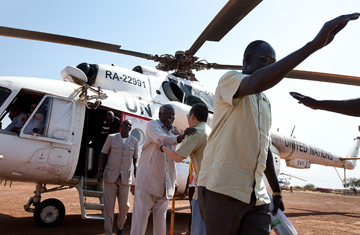
The U.N. head of mission in Abyei (C) greets Ngok Dinka leaders returning from a conference with the Missereyi Arab tribe on January 14, 2011
Over 100 people were killed in days of fighting in Sudan's hotly contested Abyei area, while thousands have fled southward away from the carnage. When south Sudan voted in January to secede, many observers warned that the move could lead to violence that could destabilize the entire region. U.S. Secretary of State Hillary Clinton called it a "ticking time bomb" and New York Times columnist Nicholas Kristof saw it as a "genocide foretold." With Sudan only months away from dividing formally into two new countries, some are now wondering: Is this the moment it all starts falling apart?
Dubbed Sudan's Kashmir, Sudan's 22-year conflict killed 2 million people before a peace deal brought fragile calm in 2005. Observers have long warned that if conflict was to break out again, it would most likely start in Abyei, a tiny area of 4,000 square miles where Sudan's northern desert peters into the marshes of the south. Claimed by both the southern Ngok Dinka, who live there year-round, and the northern Misseriya, nomadic cattle-herders who move to the area in dry months, Abyei risks being torn apart as the nation splits along the divide between its Arab north and African south.
As originally envisioned by Sudan's peace deal, the Abyei dispute was to be settled through its own special poll alongside the southern independence vote. But the Abyei vote never happened. As southerners were voting for their freedom in January, Abyei whizzed with bullets — three days of attacks left at least 41 dead. Then this week the clashes returned with a new ferocity. On Sunday and Monday, northern forces killed "about 70" southern policemen and civilian fighters, according to the south's Sudan People's Liberation Army spokesman. The attacks moved to another village on Wednesday, killing at least 33 from the southern side, says an official who watched as the bodies were buried. Casualty figures from the northern side are not known.
There is also confusion over who the attackers actually are. The northern government maintains the culprit is a Misseriya militia, acting on its own accord. The southern government in Juba says the Sudanese Armed Forces (SAF) and the north's paramilitary People's Defense Forces (PDF) were behind the attacks. As evidence, southern officials allege that two helicopters arrived at the scene of the Wednesday fighting to carry away the dead and wounded. The north has denied the use of helicopters, as well as any involvement in the conflict. "We don't support any militias," says SAF spokesman.
For Sudan watchers, it all sounds eerily familiar. During the Sudanese civil war, Arab pastoralist tribes like the Misseriya razed the bordering southern land on behalf of the government, who armed the militias and used them to open land for oil exploration, allowing them to take whatever spoils they liked from their raids in return. In Darfur, the same messy strategy was used to try to drain the armed insurgency of its civilian support, earning Sudanese President Omar Hassan al-Bashir an arrest warrant for genocide from the International Criminal Court. Even after the peace deal, the north's militia-like PDF, which U.N. officials confirm could have provided the muscle behind the recent attacks, were never disbanded. Could history be repeating itself?
One theory, voiced by local and international officials close to the situation, suggests the attacks are aimed at capturing part or all of Abyei to strengthen the north's hand in ongoing negotiations. The north has made no secret of its hope to divide Abyei in two and hang onto the oil-producing region that it already controls. Another theory holds that al-Bashir is not the puppet master, but is instead letting Misseriya hardliners take matters into their own hands. Facing an array of domestic problems, the President might be unwilling to risk turning another core constituency against his rule.
Whatever the reasons behind the Abyei violence, it has all been a poke in the eye for the U.S., which drafted the Abyei provisions of the 2005 north-south peace deal that are now in tatters. Late last year, U.S. special envoy Scott Gration led a nine-day summit in Addis Ababa dedicated entirely to re-addressing the Abyei dispute, but it ended without any agreement. The mediation mantle was then transferred to the African Union. Western officials involved say the process opened the original inked deal to re-negotiation. In the bustle, Abyei got decoupled from the wider peace process. As the U.S. makes moves to take Sudan off its list of state sponsors of terror as a reward for the peaceful January referendum, Abyei is no closer to a final resolution.
The clashes have stopped — for now. Top security officials from the north and south, as well as the top U.N. official in the country, flew in to Abyei for emergency talks on Friday. Five hours into the talks, about 200 Ngok Dinka youth demonstrators stormed the U.N. base, demanding to be let inside to address the meeting and protesting the presence of northern security officials, who they blame for the fighting.
Could the violence in one tiny piece of land throw Sudan back to war? Some see reason for hope. "The progress that the north and the south made on the referendum and on other issues gives us confidence that they can resolve the tough issues like Abyei," special envoy Gration told TIME in early February. But people in Abyei are not taking any chances. Reports from the ground suggest that half of Abyei town, or roughly 20,000 Ngok Dinka, have headed south on foot since Wednesday, fearing a full-on assault could be imminent. In 2008, Abyei town was destroyed in north-south clashes, and the memory still burns. If Abyei reverts back to war, south Sudan's birth will be a bloody one.
